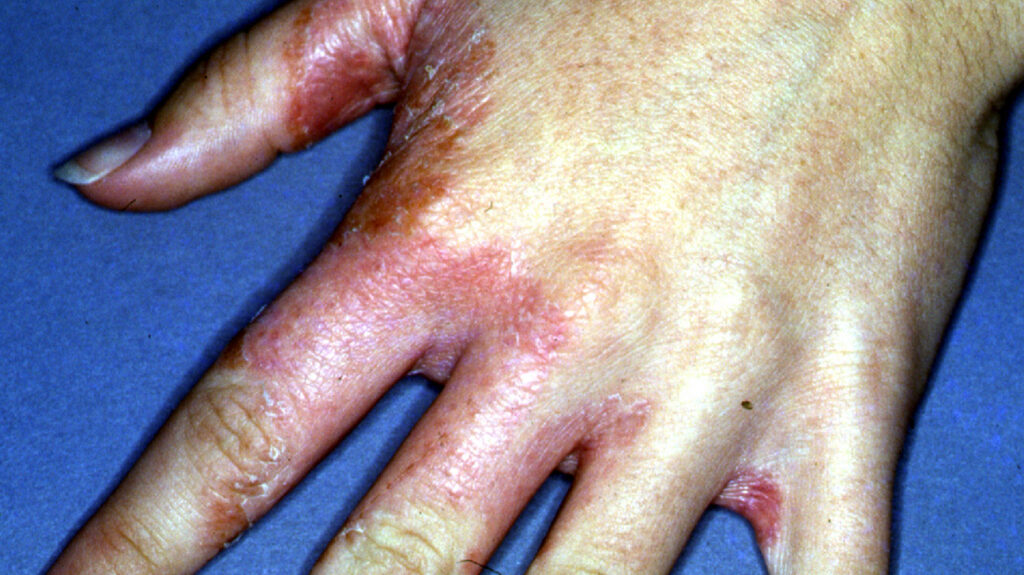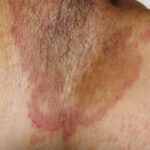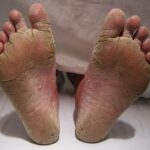Tinea manuum is a superficial dermatophyte infection that affects the palms, fingers, and interdigital spaces of the hands. Often referred to as ringworm of the hand, this condition results from dermatophyte fungi and can appear unilaterally, commonly affecting the dominant hand. It is frequently associated with concurrent infections like tinea pedis (athlete’s foot) or onychomycosis (fungal nail infection), contributing to its spread.

Etiology: What Causes Tinea Manuum?
The infection is caused by keratinophilic dermatophytes, primarily from the genera Trichophyton, Epidermophyton, and Microsporum. Common fungal species include:
- Trichophyton rubrum (most prevalent)
- Trichophyton mentagrophytes
- Epidermophyton floccosum
These fungi thrive in moist, warm environments, and the hands become infected through direct contact with contaminated surfaces or infected skin elsewhere on the body.
Common Transmission Routes:
- Autoinoculation from infected feet or nails
- Handling contaminated objects (towels, gloves, soil, tools)
- Contact with infected persons or animals
Risk Factors for Developing Tinea Manuum
Several risk factors increase susceptibility:
- Manual laborers and mechanics frequently exposed to moisture and debris
- Gardeners and farmers working with contaminated soil
- Coexisting fungal infections (e.g., tinea pedis)
- Immunocompromised individuals
- Hyperhidrosis (excessive sweating of the hands)
- Use of topical steroids masking infection and worsening progression
Clinical Presentation: Symptoms of Tinea Manuum
Tinea manuum typically presents with asymmetrical involvement, most commonly appearing on one hand only — a condition often referred to as the “two feet, one hand syndrome.”
Hallmark Symptoms Include:
- Diffuse scaling across the palm
- Hyperkeratosis with a dry, rough texture
- Annular lesions on the back of the hand with a raised, scaly border
- Fissures and cracks, especially in the creases
- Mild to intense itching or burning
- In severe cases, erythema, vesicles, or pustules may develop
Differential Diagnoses: Similar Conditions to Rule Out
Tinea manuum must be differentiated from several dermatoses that mimic its clinical presentation:
- Psoriasis: Thick, scaly plaques with silvery appearance, often bilateral
- Chronic hand eczema: Itching, scaling, and fissuring but without well-demarcated edges
- Contact dermatitis: Linked to irritant or allergen exposure; typically acute
- Palmoplantar keratoderma: Genetic or acquired thickening of palms and soles
- Scabies: Intense itching, especially at night, with burrows in the webspaces
Accurate diagnosis is essential, particularly in chronic or treatment-resistant cases.
Diagnostic Techniques for Confirming Tinea Manuum
Primary Diagnostic Tools:
- KOH Preparation: Scraping of skin examined under a microscope reveals segmented hyphae, confirming fungal presence.
- Fungal Culture: Grown on Sabouraud’s agar to determine specific fungal species — helpful for resistant infections.
- Wood’s Lamp: Generally not useful as most causative dermatophytes of tinea manuum do not fluoresce.
- Skin Biopsy with PAS Stain: Reserved for chronic, ambiguous cases; highlights fungal hyphae in the stratum corneum.
Treatment Options for Tinea Manuum
Topical Antifungal Therapy
Ideal for mild to moderate cases. Treatment should be continued at least one week beyond clinical resolution.
Commonly used agents:
- Terbinafine 1% cream
- Clotrimazole 1%
- Econazole nitrate
- Miconazole
- Naftifine hydrochloride
Application must cover the entire affected area plus 2 cm beyond the border.
Systemic Antifungal Therapy
Indicated in extensive, recurrent, or resistant cases, or when nail and foot involvement is present.
Recommended medications:
- Terbinafine 250 mg daily for 2–4 weeks
- Itraconazole 100–200 mg daily for 2–4 weeks
- Fluconazole 150 mg once weekly for 4–6 weeks
- Griseofulvin (used less frequently due to side effects)
Preventive Measures to Avoid Reinfection
To prevent recurrence and control transmission:
- Treat concurrent fungal infections (feet, nails, groin)
- Keep hands clean and dry at all times
- Avoid sharing towels, gloves, or tools
- Use antifungal powders if excessive sweating occurs
- Wear gloves when handling contaminated soil, animals, or surfaces
- Sanitize tools and household items regularly
Potential Complications
Without timely and appropriate treatment, tinea manuum may lead to:
- Chronic, relapsing infection
- Spread to other areas of the body (e.g., groin, feet, nails)
- Bacterial superinfection due to cracked skin
- Tinea incognito caused by corticosteroid misuse
- Psychosocial stress due to visible hand involvement
Key Insights on Tinea Manuum
- Tinea manuum is a fungal infection of the hand, often linked with tinea pedis or onychomycosis.
- Common symptoms include dryness, scaling, annular lesions, and itching.
- Diagnosis is confirmed through KOH prep and fungal culture.
- Topical antifungals are first-line therapy; oral agents for extensive disease.
- Hygiene and environmental control are critical for prevention.
Frequently Asked Questions:
Can tinea manuum affect both hands?
Typically, tinea manuum affects only one hand, most often the dominant one. Bilateral hand involvement is rare and suggests other dermatoses.
How long does it take to cure tinea manuum?
With appropriate antifungal therapy, mild cases resolve within 2 to 4 weeks. Chronic or severe infections may require longer treatment.
Can I get tinea manuum from my pet?
Yes. Some dermatophytes like Microsporum canis are zoophilic and can be transmitted from infected animals to humans.
Are over-the-counter creams effective?
Yes. For mild cases, OTC antifungals like terbinafine and clotrimazole are effective. Persistent symptoms require prescription-strength medication.
Is tinea manuum contagious?
Yes. It is highly contagious and can spread through direct contact or indirectly via shared items like towels or gloves.

